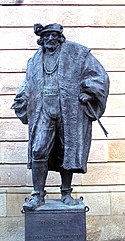Nuremberg and its art to the end of the 18th century. (1905) (14797363463)
Identifier: nurembergitsartt00repa (find matches)
Title: Nuremberg and its art to the end of the 18th century.
Year: 1905 (1900s)
Authors: Rée, Paul Johannes, b. 1858 Palmer, G. H. (George Henry), b. 1871, tr
Subjects: Art
Publisher: London : H. Grevel & Co. New York : C. Scribner's Sons (etc., etc.)
Contributing Library: Boston Public Library
Digitizing Sponsor: Boston Public Library
View Book Page: Book Viewer
About This Book: Catalog Entry
View All Images: All Images From Book
Click here to view book online to see this illustration in context in a browseable online version of this book.
Text Appearing Before Image:
e Masters studio; at Regensburg, the imaginative Albrecht Alt-dorfer, were working, on the basis Diirer had provided, to attain richerefifects of colour, akin to the Netherlandish chiaroscuro, but it lives also inthe artistic movement of our own time, in which Diirer has appeared as theproper guide in thesummons back tonature. Besides Hans Bal-dung Grien, namedabove, we know ofHans Leonard Schau-felein among Diirersassistants. He wasborn at Nurembergabout 1480 and livedthere at first. After-wards he wanderedto Augsburg, andlater to Nordlingenwhere he did a greatdeal of work. Histechnique is free andvigorous, but hispictures, which aresplendid in colour,are generally want-ing in drawing, andlack real feeling anddepth (see fig. 82).His work for wood-cuts deserves pro-minence, especiallyhis share in theillustration of theTheuerdank. Hans Springinklee, who ^^S* ^3- Hans von Kulmbach: St. Cosmas and St. Damian. 1 -,1 1 ■ , In the Germanic Museum. pleases with his de- Photograph by Hofle.
Text Appearing After Image:
126 DURERS PUPILS. corative architectural accessories, worked also especially at book illustration.We learn of him that he lived with Diirer, and acquired his art there, sothat he became famous in painting and drawing. Among the painters at work at Nuremberg at the beginning of the16* century, was the variously named Jacopo de Barbari, called Jacob Walch,of whom Diirer thought so much. He however, as has lately been clearlyestablished, received just as much as he gave. Hans Suess, called Hans vonKulmbach, because he came from that place, was a pupil of Barbari and moreinfluenced by him than Diirer was. Still, even he owes his best qualificationsto Diirer, having worked later in his studio and formed a close friendship withhim. From 1514 to 1518, he worked at Cracow, and that city owns his bestworks. They are distinguished for delicate and graceful forms and harmonious colouring. In accordance witha sketch of Diirers, he painted,in 1513, the beautifully com-posed Tucher altarpiece inSt
Note About Images
Relevante Bilder
Relevante Artikel
Hans von KulmbachHans von Kulmbach auch Hans von Culmbach, eigentlich Hans Suess, auch Hans Süß von Kulmbach, war ein deutscher Maler, Zeichner und Grafiker. .. weiterlesen








